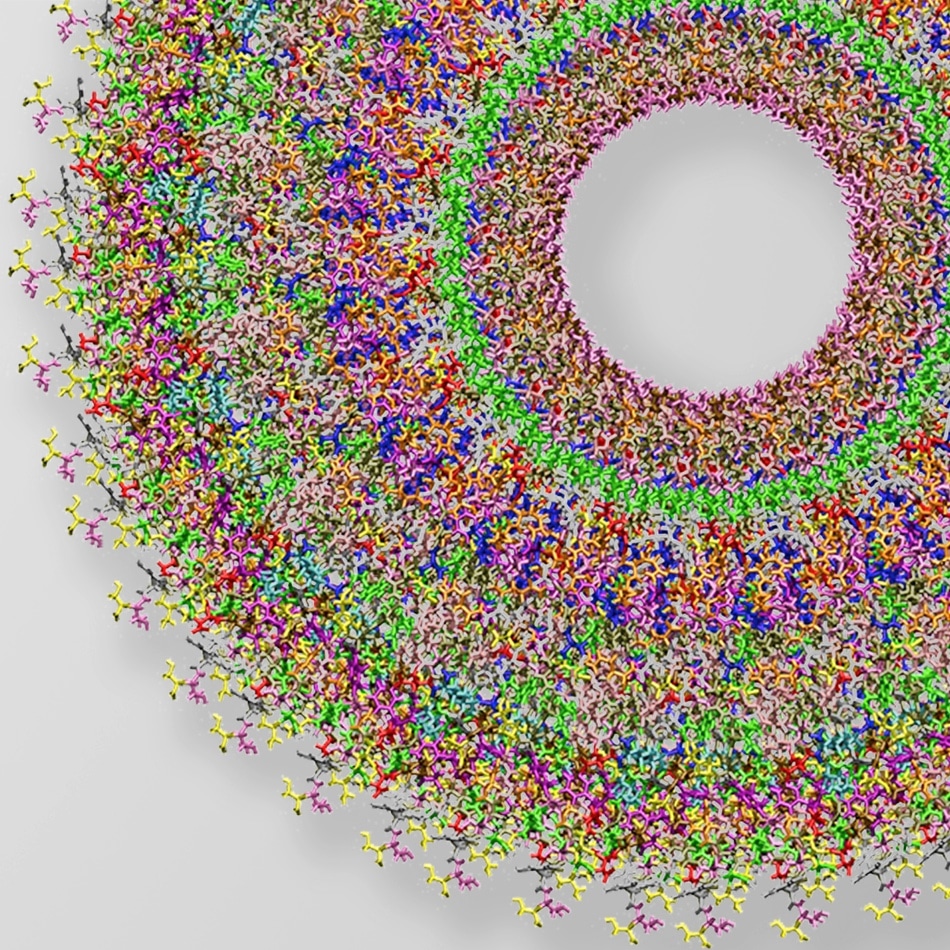Apr 5 2018
New materials are required for new developments. Until now, new materials have been mostly developed by performing tedious experiments in the laboratory. At the Fraunhofer Institute for Algorithms and Scientific Computing SCAI in Sankt Augustin, researchers are now applying a "Virtual Material Design" approach along with the specially developed Tremolo-X software to considerably reduce this cost-intensive and time-consuming process.
Better materials can be developed much more rapidly by integrating data analysis, multi-scale models, and machine learning. Fraunhofer will demonstrate the virtual material design of the future (Hall 6, Booth A30) at the Hanover Trade Fair, which will be held from April 23 to 27, 2018.
 Even tiny objects can be depicted in detail: here an atomistic model of the tobacco mosaic virus. The tubular virus is about 300 nm long and 18 nm in diameter. (Image credit: © Fraunhofer SCAI)
Even tiny objects can be depicted in detail: here an atomistic model of the tobacco mosaic virus. The tubular virus is about 300 nm long and 18 nm in diameter. (Image credit: © Fraunhofer SCAI)
In almost all industries, new developments demand new materials. For instance, in the automotive sector, while automobile used to include only a small number of materials, contemporary cars are assembled from a countless number of different materials – and demand continues to rise. Be it making a car lighter, developing electric motor batteries, or getting better fuel economy, every innovative development needs to find or develop the material that possesses the right properties.
However, the quest for the right material has mostly been like a guessing game. Usually, the candidates have been chosen from vast material databases and subsequently tested. While these material databases offer some amount of understanding about the particular performance characteristics, they often do not provide enough insight to make meaningful judgments regarding whether a material possesses the required properties. In order to find that out, various laboratory tests have to be carried out.
At the Fraunhofer SCAI, the researchers have selected a unique approach, in which the requirements for the particular substance are broken down to the material’s inner structure—that is, down to the atomic level. Tremolo-X—a specially developed software—subsequently calculates the way the material’s particles react when exposed to certain physical effects. Consequently, a conclusion can be reached whether a material with the preferred properties can be developed based on these particles.
Virtual Predictive Models and Atomistic Simulations
"Our goal is to shorten the search for the right material. This process often takes ten to twenty years, which is not only time consuming but also costly," says Dr. Jan Hamaekers from the Fraunhofer SCAI. "The idea is to use virtual processes to sift out the number of candidates until there are only a few left to be tested in the lab."
In order to do this, it is first important to define the requirements placed on the material. For instance, what loads a material has to endure or how fast it has to cool down. This is replicated in two completely different ways on a computer with the help of the Fraunhofer software: At the atomic or even at the quantum level, virtual particles are simulated. How do the particles interact with each other? How do they behave? In the other approach, existing knowledge and data are used to obtain prediction models that make it possible to predict a material’s properties.
"The aim is to improve, create and explore new innovative materials and molecules with effective properties in the virtual computer lab in order to recommend their structure and design prior to the actual synthesis," Hamaekers explains.
Multiscale Modeling: From the Atom to the Process Chain
During multi-scale modeling, as utilized in the chemical industry (among others), the procedure becomes quite clear. Here, the material’s chemistry is elucidated at the quantum level. This data is then transferred to ever coarser models that are capable of mapping molecules and their physical properties.
If we want to predict how good the electrolyte is or how fast the ions are diffusing in the case of a lithium-ion battery, for example, we first simulate the particles at the quantum level and see what happens to them. Then, we take that information to the next level and gain insight into the dynamics, or how the particles move at the atomic level. From here, we can then go up a scale and look at how the electrolyte behaves in the macroscopic world. This gives us precise insights into all the processes and, if necessary, we can adapt or change processes.
Dr. Jan Hamaekers
In this manner, in addition to developing new materials or finding appropriate materials for particular applications, processes can also be reviewed and enhanced. By replicating the processes at the molecular or atomic level in a virtual reactor, the parameters or points can be precisely identified and optimized.
At the Hanover Trade Fair 2018, the Fraunhofer SCAI employs distinct examples to demonstrate how the design of materials can be enhanced through data analysis, modeling, and machine learning.